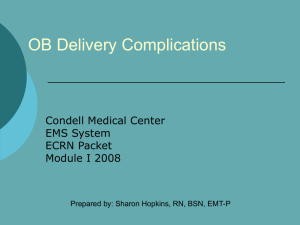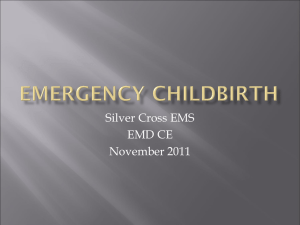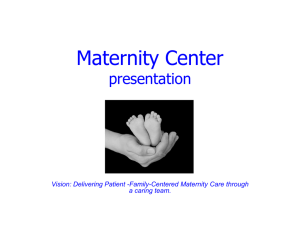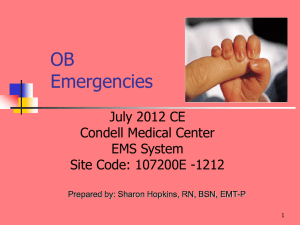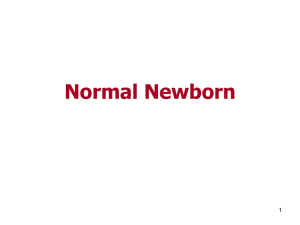November 2010 CE: OB Emergencies
advertisement
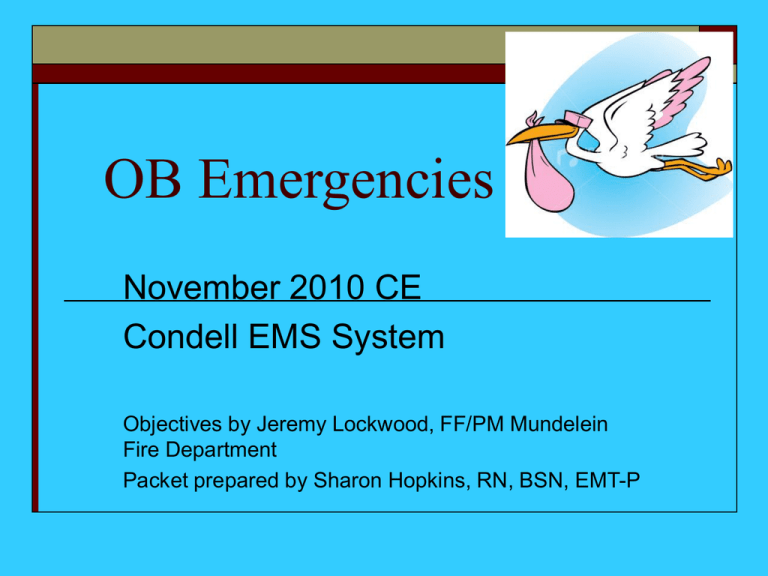
OB Emergencies November 2010 CE Condell EMS System Objectives by Jeremy Lockwood, FF/PM Mundelein Fire Department Packet prepared by Sharon Hopkins, RN, BSN, EMT-P Objectives Upon successful completion of this module, the EMS provider will be able to: 1. Identify appropriate standard precautions in the OB delivery setting. 2. Identify progression of a normal pregnancy. 3. Describe assessment of an obstetrical patient. 4. Identify predelivery complications. 5. Describe indications and signs of imminent delivery. 6. Identify the stages of labor. Objectives cont’d 7. List the contents of the OB kit 8. Describe how to use the contents of the OB kit. 9. Describe the steps in assisting delivery of the newborn. 10. Describe care of the newborn baby. 11. Describe APGAR scoring. 12. Describe when and how to cut the umbilical cord. 13. Describe the delivery of the placenta. 14. Describe post delivery care of the mother. Objectives cont’d 15. Describe abnormal deliveries and procedures. 16. Identify and describe delivery complications. 17. Describe meconium staining and its implication to the newborn. 18. Review documentation components for discussed conditions. 19. Given a manikin, demonstrate use of the OB kit. 20. Demonstrate use of the meconium device. Standard Precautions Anticipate the exposure to a large amount of blood and body fluids Full protection is recommended Don’t assume the absence or presence of disease just by appearances of the patient or situation Standard Precautions Handwashingstill most effective control measure around Just Protect Yourself!!! Do what you can Normal Pregnancy Development Ovulation and what follows Release of an egg from ovary Egg travels down fallopian tube toward uterus Intercourse within 24-48 hours of ovulation could result in fertilization Fertilization occurs in the fallopian tube Fertilized egg will implant in the uterus and pregnancy begins Prenatal Development cont’d Placental development Approx 3 weeks after fertilization Blood rich structure for the fetus Transfers heat Exchanges oxygen and carbon dioxide Delivers nutrients Carries away waste products Endocrine gland Secretes hormones for fetal survival Secretes hormones to maintain pregnancy Placental Development cont’d Protective barrier Connected to the fetus via the umbilical cord Flexible, rope-like structure 2 feet in length; ¾″ diameter Contains 2 arteries, 1 vein 2 arteries return relatively deoxygenated blood to the placenta 1 vein transports oxygenated blood to fetus Placental Attachment Amniotic Sac “Bag of waters” Thin-walled membranous covering holds the amniotic fluid Surrounds and protects fetus Allows for fetal movement during development Volume varies from 500 ml to 1000 ml 500 ml = 1 pint = 2 cups Premature rupture increases risk of maternal and fetal infection that could be life threatening Physiological Changes of Pregnancy Due to: Altered hormone levels Mechanical effects of enlarging uterus Increased uterine blood supply Increasing metabolic demands on the maternal system Physiological Changes to the Systems Reproductive system Uterus becomes larger Contains 16% of the mother’s blood during pregnancy Respiratory system Increase in oxygen demands 20% increase in oxygen consumption 40% increase in tidal volume Slight increase in respiratory rate Diaphragm pushed upward Physiological Changes to the Systems Cardiovascular system Cardiac output increases Maternal blood volume increases by 45% More plasma increase than red blood cells so relative anemia develops Maternal heart rate increases by 10-15 beats B/P decreases slightly 1st & 2nd trimesters Supine hypotensive syndrome when mother lies supine Especially by 5 months of pregnancy Physiological Changes to the Systems Gastrointestinal system Nausea & vomiting are common in 1st trimester Delayed gastric emptying (due to slowed peristalsis) Bloating and constipation common Physiological Changes to the Systems Urinary system Renal blood flow increases More likely to have glucose spilling into urine Bladder displaced anteriorly & superiorly increasing likelihood of rupture during trauma Urinary frequency is common especially 1st trimester Physiological Changes to the Systems Musculoskeletal system Pelvic joints loosened causing waddling gait Center of gravity shifts with enlarging uterus Postural changes taken to accommodate for increased anterior growth Increased complaints of low back pain Obstetrical Assessment Need to determine if delivery is imminent or if there is time to transport Remain calm (at least on the outside!) Ask a few questions Basically direct or closed ended questions – requiring a simple answer in few words Perform a visual examination Evaluate vital signs Remain calm (at least on the outside!) OB Assessment Questions Expected due date The more premature, the smaller the birth weight and the less mature the lungs Number of pregnancies The higher the number, the quicker they tend to deliver Length of labor 1st pregnancies can take up to 16-17 hours Subsequent deliveries tend to shorten from the 1st one OB Assessment Questions If bag of waters have ruptured or are intact Once ruptured, delivery tends to progress faster Once ruptured, must be evaluated due to increase risk of infection especially if not delivered within 24 hours Feeling of having to move their bowels This is from pressure of the fetal head moving through the birth canal OB Visual Examination Gain rapid rapport with the mother Disrobe the under garments Visually inspect the perineum Check for crowning or bulging The appearance of the presenting part at the vaginal opening Prepare for imminent delivery if crowning Best to check during a contraction Check for blood loss Check for other parts – fingers, toes, cord OB Assessment - Contractions Place gloved palm on mother’s abdomen Contraction duration Time from the beginning of one contraction (uterus tightens) to the end (when uterus relaxes) Contraction interval or frequency Time from the start of one contraction to the beginning of the next one Includes contraction and rest intervals OB Assessment – Vital Signs Routine vital signs are taken Remember physiological changes of pregnancy: Blood pressure, after initial drop, is near normal in 3rd trimester Heart rate up by 10-15 beats over normal Only slight increase in respiratory rate Supine Hypotensive Syndrome Caused by the weight of an enlarging uterus pinching off blood supply in the inferior vena cava Decreases blood return to the heart Decreases stroke volume pumping out of the heart Especially after 5 months transport the mother tilted or turned preferably toward the left Imminent Delivery Crowning is present Contractions last 30 – 60 seconds and are 2 - 3 minutes apart Mother has the urge to move her bowels or she says “I HAVE TO PUSH!!!” Bag of waters has ruptured Stages of Labor 3 stages of labor 1st stage – dilatation stage Begins with onset of true labor contractions Ends with complete dilatation (10 cm/4″) & effacement (100%) of the cervix Is manually confirmed in the hospital setting, not field Stage can last approximately 8-10 hours for first labor to about 5-7 hours in multipara 1st Stage of Labor cont’d Contractions Early in this stage are usually mild Increase in intensity as labor progresses Duration of 15-20 seconds Frequency every 10-20 minutes apart Duration of 60 seconds Frequency every 2-3 minutes Care is supportive at this point in time Allow husband/significant other to time contractions Keeps them busy, involved, and out of the way Timing Contractions Duration Timed in seconds Timed from the beginning of the contraction to the end the contraction Contractions lasting 60-90 seconds indicate imminent delivery Frequency Timed in minutes Timed from the beginning of one contraction to the beginning of the next contraction Contractions coming every 2-3 minutes indicate imminent delivery 2nd Stage of Labor – Expulsion Stage Begins with complete dilatation of cervix Ends with delivery of fetus Can last 50 – 60 minutes for the first delivery Can last 30 minutes for future deliveries Contractions strong, uncomfortable Duration is 60-75-90 seconds Contraction every 2 – 3 minutes 2nd Stage of Labor cont’d Mother has urge to bear down Mother has back pain Crowning is evident on visual inspection Membranes usually rupture now OB kit should be open by now Be ready to support mother in delivery OB Kit May be supplied in a variety of packaging If extra supplies are needed, where are they kept? Always anticipate using the OB kit Better to have it available and not need it / use it than need it and not have it Kits are usually packaged with disposable products Practice Standard Precautions Goggles, mask, gloves, gown Contents of OB Kit Cord Clamps FYI If not used for a period of time, it has been reported that the OB clamps become brittle and can break There is no hurry to clamp and cut a cord If you transport the mother and baby with the cord intact, so be it The hospital will take care of clamping and cutting the cord Delivery of the Newborn As soon as the head and neck emerges, check for nuchal cord and begin to suction mouth then nose with bulb syringe Depress bulb first before insertion of mouth, then nose To facilitate delivery of upper shoulder, gently guide head downward Support and lift head and neck slightly to deliver lower shoulder Rest of infant delivers passively and very quickly Newborn At Delivery They’ll grow into being a Gerber baby! Care of the Newborn cont’d Hold on tight Infant is slippery due to cheesy covering and amniotic fluid Note time of delivery and record on the infant’s run report Stimulate the infant Suctioning, rubbing the back, flicking at the soles of the feet, drying off Suctioning the Newborn Suction mouth then nose always in that sequence Infant’s are obligate nasal breathers Want to clear the airway before stimulating them to take a breath Always depress bulb syringe and THEN place into infant’s mouth, then nose Care of the Newborn Continue to suction mouth then nose Spontaneous respirations should begin within 15 seconds after stimulation If no respirations, begin BVM support at 3040 breaths per minute If pulse < 60 or between 60-80 and not improving, begin CPR Obtain 1 minute APGAR (ie: record as 9/10) APGAR Score Assesses newborn adjustment to extrauterine life 1 minute score indicates need for resuscitation 5 minute score predicts mortality and neurological deficits Order of importance Heart rate Respiratory rate Muscle tone Reflex irritability Finally color – least helpful; most visible/obvious APGAR Scoring – 1 & 5 minutes Care of the Umbilical Cord Clamp and then cut the cord after pulsations have stopped & cored is limp Clamps placed 8″ from infant’s navel 2″ apart Watch the end of the cord for leakage of blood If leaking, add additional clamps moving toward the infant’s navel Cutting the Clamped Cord FYI – What About Cord Blood? Obtained in the hospital within 10-15 minutes of delivery Collected from umbilical cord after delivery and after care of newborn provided Consists of stem cells that can transform into variety of healthy tissue Useful to treat leukemia, lymphomas and other diseases Fee charged for private donations and storage NOT the same as embryonic stem cells Care of The Newborn cont’d Continue to dry and wrap infant to preserve body temperature Obtain 5 minute APGAR (ie: record as 10/10) Continue to suction mouth then nose as needed Keep infant in head downward position Facilitates drainage from the airway Assess vital signs of infant (is it time to retake mom’s?) Care of the Newborn Infant in head down (and side lying) position Hat placed to minimize heat loss Cord clamped and cut 3rd Stage of Labor – Placental Stage Begins immediately after delivery of infant Ends with delivery of placenta Do not need to delay transport waiting for placenta to deliver Signs of separation Gush of blood from vagina Change in size, consistency, shape of uterus Lengthening of cord protruding from vagina Delivery of the Placenta Allow to deliver spontaneously May take up to 20 minutes after infant delivered to deliver the placenta If delivered at the scene, collect and transport with the patient Inspected for retained placental parts For excessive external bleeding, apply dressings externally For excessive vaginal bleeding, uterine massage AFTER placenta is delivered Placenta Uterine Wall Side Placenta Fetal Side Post Partum Care of the Mother What is post partum hemorrhage? Loss of more than 500 ml of blood (1 pint; 2 cups) To control, massage uterus AFTER delivery of placenta Will feel uncomfortable to the mother Massage until the uterus feels firm Recheck every 5 minutes Check your rate of IV fluids Are you administering oxygen? Fundal Massage Performed AFTER delivery of placenta Uterus should be firm Place one hand immediately above symphysis pubis Place one hand on uterine fundus (top) Massage with 2 hands Post Partum Care Congratulate the new parents! Inform them if it is a boy or girl If possible, offer the mother a towel to wipe her face and hands By holding the wrapped infant, the mother’s body heat will help maintain the body heat of the infant Abnormal Delivery Presentations If you are prepared for the worst and get the best, hidden bonus!!! Breech 4% of term deliveries Head is not the presenting part!!! Transport immediately to closest ED with OB capacity Higher risk to infant and mother Potential need for C-section To Facilitate Delivery of Breech As soon as legs deliver, support infant’s body If accessible, palpate cord for pulsations Attempt to loosen cord to create slack After torso & shoulders deliver, gently sweep arms down If face down, gently elevate legs & trunk to facilitate delivery of head DO NOT HYEREXTEND HEAD DO NOT PULL ON INFANT If Head Does Not Deliver in 30 Seconds Reach 2 gloved fingers into vagina to locate newborn’s mouth Push vaginal wall away from newborn’s mouth Keep fingers in place and transport immediately Call report ASAP Keep delivered portion of infant warm & dry If infant delivers, anticipate distressed newborn Anticipate maternal hemorrhage Footling Breech – Not a Field Delivery If one foot is visible, wonder “where is the rest of the baby?” Encourage mother to breath through a contraction so she does not add to the pushing Keep infant’s extremity warm Rapid transport Early report Prolapsed Cord Cord is delivering before the infant Infant’s oxygen and blood supply will be compromised Need to take pressure off the cord Don’t want mother pushing with contractions Have mother breath through the contractions Prolapsed Cord True emergency High fetal death rate Must immediately recognize the emergency Rapid transport Place gloved fingers into vagina between pubic bone and presenting part Cover exposed cord with moist saline dressing Placenta Previa Abnormal implantation of placenta on lower half of uterine wall Partial or complete blockage of cervical opening Hallmark: Painless, bright red vaginal bleeding Uterus usually soft Abruptio Placenta Premature separation of normally implanted placenta from the uterine wall 20-30% fetal mortality rate Bleeding concealed Sudden, sharp, tearing pain and stiff, boardlike abdomen Life threatening OB emergency Support mother’s oxygenation Transport tilted or lying left Meconium Staining Meconium is fetal stool Release by the fetus may indicate intrauterine stress, like hypoxia If observed, prepare for a distressed baby who may need ventilatory support Fortunately, most meconium can be dealt with by using a bulb syringe Meconium Aspiration Equipment Intubation equipment Blade, handle 2 ET tubes Meconium aspirator Suction Suction turned down to 80mmHg Meconium Aspiration Procedure Meconium aspirator connected to suction tubing Intubate in usual manner May not visualize landmarks due to meconium Quickly connect aspirator to ET tube Withdraw in twisting fashion while suctioning Minimize suction time to 2 seconds or less If time, repeat at least once more Meconium Aspirator Time available to intervene is minimal Must be prepared and move fast While running slide show, left click anywhere on screen at right to play video Multiple Births Prepare for more than one delivery Where is your extra equipment? Expect smaller birth weight infants Poorer ability to conserve body heat Immature respiratory system Need for the smallest equipment you carry Stressed Newborn Infant flaccid, no muscle tone Heart rate < 100 If < 60 begin chest compressions Apneia or respiratory distress Newborn respiratory rate 40-60 per minute Support ventilations via BVM One breath every 3 seconds Just enough volume to make chest rise and fall Documentation After delivery you have 2 patients Complete run report for both the mother and the newborn Include time of delivery Note the one person who actually “caught” the infant at time of delivery Keep mother’s information on the mother’s report; infant’s on the infant’s Apply wristbands to both mother and newborn Case Scenario #1 You have arrived on the scene. 27 year-old woman says she is in labor What are the indications for imminent labor? Urge to move bowels Urge to push Crowning Ruptured bag of waters Contractions every 2-3 minutes lasting 60-90 seconds Case Scenario #1 What questions do you need to ask specific to mother being in labor? What number pregnancy is this? What is her due date? What are her contractions like? Does she have the urge to push? Is her bag of waters intact or broken? Is she aware of any complications? Case Scenario #1 Describe the exam you need to perform Visual inspection of perineum Looking for crowning Looking for abnormal presentation – fingers or toes, anything not expected Looking for a prolapsed cord Checking for blood loss Evaluate contraction duration and frequency Case Scenario #2 You have responded to the scene of a 34 year-old mother in labor Upon visual inspection, you note flecks of meconium in the leaking amniotic fluid What does this indicate? Anticipate a distressed infant The infant will need gentle, aggressive airway care with the bulb syringe and possibly the meconium aspirator Case Scenario #2 What equipment is necessary? Bulb syringe Intubation equipment Blade Handle ETT – 2 available (if the first one is clogged with meconium) Stylet Suction tubing Meconium aspirator Case Scenario #2 What adjustment needs to be made with the suction when using the meconium aspirator? Suction needs to be turned down to 80 mmHg Suction generally set at 300 mmHg for the adult population Limit suctioning to less than 2 seconds Case Scenario #3 You are on the scene for a 17 year-old in labor Upon visual inspection, you note a prolapsed cord What interventions do you take? Immediately place gloved fingers into the vagina to take pressure off the cord Place the mother in the knee-chest position Provide rapid transport with early report End of this case discussion; move to next case Case Scenario #4 You are on the scene of a 2 car collision One of the patients is 16 years-old and is 6 months pregnant What would be the recommended position if transported? Lying or tilted left to keep pressure off vena cava Can this patient sign a release if she wants to? She is emancipated and can sign a release If she remains the parent after delivery, she remains emancipated End of case discussion; move to next case Case Scenario #5 - Documentation What’s right? What’s wrong/missing? MVC –this is what’s provided: Deformity to steering wheel; windshield starred Extrication took 15 minutes Patient complained of back pain; able to move upper extremities Swelling noted to left upper quadrant Case Scenario #5 What’s right regarding documentation? Description of damage to car Need and length of time for extrication Patient complaints listed Visual inspection result to abdomen Case Scenario #5 What’s wrong/missing? Is there any other information from the accident available or not? Speed; what was hit or what hit car Location of occupant in car More descriptive of head to toe assessment Distal CMS with back pain Movement of lower extremities Palpation results of abdomen Case Scenario #5 What does SMV’s stand for? Sensation, movement, vascular What does CMS stand for? Circulation, motor, sensation How do you test for them (yes, they are the same)? Feel for pulses Ask the patient to move a distal digit Ask the patient if they can feel a touch that they are not staring at Case Scenario #6 - Documentation What’s right? What’s wrong/missing? 78 year-old with chest pain – this is what’s provided Onset at 0800 while watching TV Not relieved with rest or 2 Nitroglycerin tablets 8/10 pain scale EKG sinus rhythm 12 lead done IV, O2, Aspirin and nitroglycerin given Case Scenario #6 What’s right regarding documentation? Onset – what patient was doing Palliation/provocation Severity Time of onset Care provided Rhythm strip results 12 lead obtained Interventions appropriate Case Scenario #6 What’s wrong/missing? OPQRST not complete Missing quality of chest pain in patient’s own words Missing if the pain radiates or not Was any ST elevation observed on 12 lead? Was 12 lead faxed to Medical Control? Case Scenario #7 EKG Interpretation Any ST elevation? Case Scenario #7 – Acute MI ST Elevation I, aVL, V2, V3, V4, V5, V6 Case Scenario #8 – EKG Interpretation Any ST elevation? Case Scenario #8 – Acute MI ST Elevation II, III, aVF Hold nitroglycerin until consult with Medical Control (hypotension a possibility with inferior wall MI) Hands-on Practice Practice with contents of OB kit Practice positioning newborn in head down position Practice using the bulb syringe to clear first the mouth then the nose Paramedics to use the meconium aspirator Practice in pairs to become most efficient with time Bibliography American Academy of Pediatrics. Pediatric Education for Prehospital Professionals 2nd Edition. 2006. American Academy of Pediatrics. Neonatal Resuscitation. 2000. Bledsoe, B., Porter, R., Cherry, R. Paramedic Care Principles and Practices. Prentice Hall. 2009. Limmer, D., O’Keefe, M. Emergency Care 10th Edition. Brady. 2005. Region X SOP, March 2007; amended January 1, 2008.

